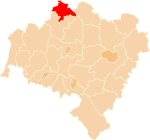Andreas Gryphius Theatre in Głogów

The Andreas Gryphius Theatre in Głogów - a classical theater building located in Głogów, in the central part of the Old Town, next to the town hall. It was built in 1799 according to the design by Christian Valentin Schultze as the seat of a multi-department theater, offering several stage genres at once. The theater operated in the building almost until the end of World War II, when the edifice, along with the entire town, was destroyed as a result of the Soviet offensive on Głogów. In the following decades, different concepts of rebuilding the Głogów theater were proposed, but none of them was implemented. Eventually, the building was rebuilt to its pre-destruction condition in 2017-2019 to house a branch of the Municipal Cultural Center and at the same time host concerts and performances, as well as conferences.
Excerpt from the Wikipedia article Andreas Gryphius Theatre in Głogów (License: CC BY-SA 3.0, Authors, Images).Andreas Gryphius Theatre in Głogów
Rynek,
Geographical coordinates (GPS) Address Website External links Nearby Places Show on map
Geographical coordinates (GPS)
| Latitude | Longitude |
|---|---|
| N 51.66352 ° | E 16.09401 ° |
Address
Teatr Miejski im. Andreasa Gryphiusa
Rynek 8
67-200
Lower Silesian Voivodeship, Poland
Open on Google Maps






